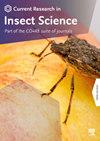Bacterial dynamics and exchange in plant-insect interactions
IF 2.7
Q1 ENTOMOLOGY
引用次数: 0
Abstract
In nature, plants and insects engage in intricate interactions. Despite the increasing knowledge of the microbiomes of plants and insects, the extent to which they exchange and alter each other's microbiomes remains unclear. In this work, the bacterial community associated with nymphs of Philaenus spumarius (Hemiptera: Aphrophoridae), the stems of Coleostephus myconis where the nymphs were feeding, and the foam produced by the nymphs, were studied by culture-dependent and -independent approaches, with an attempt to elucidate the exchange of bacteria between plants and insects. The results suggest that both approaches complement each other, as many bacterial genera identified by metabarcoding were not detected by culturing, and vice versa. Overall, stems and foam exhibited higher bacterial diversity than nymphs, with all the samples showing enrichment in bacteria known to provide diverse benefits to their host. Stems and foam were the most similar in bacterial composition, but Burkholderiaceae and Moraxellaceae dominated the stems, whereas Rhizobiaceae and Sphingobacteriaceae dominated the foam. Nymphs exhibit the most distinct bacterial composition, yet more similar to that found in the stem compared to the foam. Indeed, nymphs were enriched on endosymbiotic bacteria, mostly Candidatus Sulcia and Sodalis, not found in the stem and foam. Nevertheless, during feeding, nymphs appeared to exchange several bacteria genera with C. myconis, with a significant number being incorporated into the bacteriome of the nymph. The genera Curvibacter, Cutibacterium, Methylobacterium, Pseudomonas and Rhizobium are likely the most exchanged. Nymphs also appear to exchange bacteria to the foam, notably species from the Enhydrobacter, Pseudomonas, Rhizobium and Roseomonas genera. More studies to infer the functions of the shared bacteria between P. spumarius-C. myconis are needed.

植物-昆虫相互作用中的细菌动力学和交换
在自然界中,植物和昆虫进行着错综复杂的相互作用。尽管人们对植物和昆虫的微生物组的了解越来越多,但它们之间交换和改变彼此微生物组的程度仍不清楚。本文采用培养依赖和非培养依赖的方法,研究了与spumarius Philaenus spumarius(半翅目:aphrophididae)若虫相关的细菌群落、myconis Coleostephus myconis若虫取食的茎部以及若虫产生的泡沫,试图阐明植物与昆虫之间的细菌交换。结果表明,这两种方法是互补的,因为许多通过元条形码识别的细菌属在培养中未被检测到,反之亦然。总体而言,茎和泡沫比若虫表现出更高的细菌多样性,所有样品都显示出已知的细菌丰富,为其宿主提供多种益处。茎和泡沫的细菌组成最相似,但茎以burkholderaceae和Moraxellaceae为主,而Rhizobiaceae和sphingobacteraceae则以泡沫为主。若虫表现出最独特的细菌组成,但与泡沫相比,在茎中发现的细菌更相似。事实上,若虫富含内共生细菌,主要是在茎和泡沫中没有发现的Candidatus Sulcia和Sodalis。然而,在摄食过程中,若虫似乎与霉菌交换了几个细菌属,其中有相当数量的细菌被纳入若虫的细菌群。曲线菌属、表皮菌属、甲基菌属、假单胞菌属和根瘤菌属可能是交换最多的。若虫似乎也会将细菌交换到泡沫中,特别是来自水螅杆菌、假单胞菌、根瘤菌和玫瑰单胞菌属的细菌。更多的研究来推断p.s umumarius - c之间共有细菌的功能。Myconis是需要的。
本文章由计算机程序翻译,如有差异,请以英文原文为准。
求助全文
约1分钟内获得全文
求助全文
来源期刊

Current Research in Insect Science
Agricultural and Biological Sciences-Animal Science and Zoology
CiteScore
3.20
自引率
0.00%
发文量
22
审稿时长
36 days
 求助内容:
求助内容: 应助结果提醒方式:
应助结果提醒方式:


